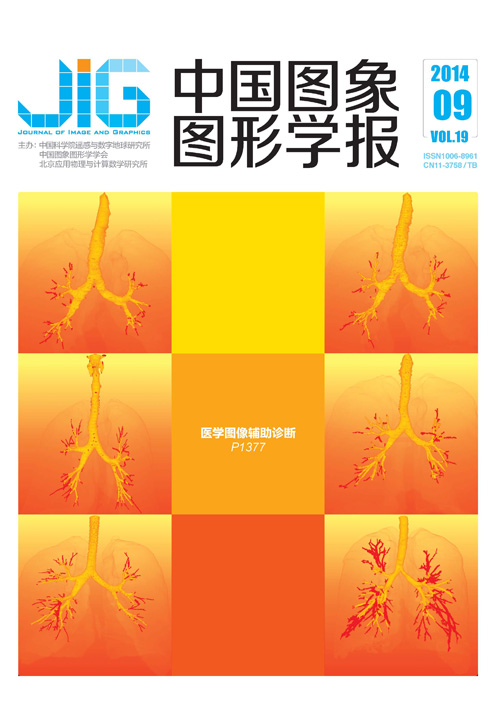
结合特征适配与拉普拉斯形变的3维人脸重建
摘 要
目的 数字娱乐产业的发展要求3维人脸重建技术能重建高分辨率3维人脸,并具有较高计算效率和重建准确性。针对这一情况,提出一种基于单幅图像的高分辨率3维人脸重建方法。方法 该方法包含特征适配与拉普拉斯形变两部分。预先用1组3维人脸样本上的3维特征构造可变形模型。给定图像时,从其上自动提取2维特征点,并根据获得问题最优解的必要条件进行特征适配以重建个性化3维特征;然后基于拉普拉斯方法,用该3维特征对一般人脸模型进行变形以获得特定高分辨率3维人脸;最后通过纹理合成获得真实感人脸。结果 用本文方法和已有方法分别进行可变形模型适配和模型变形,本文的特征适配方法具有更快的收敛速度和更高的准确性,拉普拉斯方法具有更小的重建误差。纹理映射后的3维人脸具有很好的视觉效果。结论 本文方法将特征适配与拉普拉斯形变结合起来进行高分辨率3维人脸重建。实验结果表明所提出的方法具有较高的计算效率和准确性,能实现较为理想的高分辨率3维人脸重建。
关键词
Three dimensional face reconstruction via feature adaptation and Laplace deformation
Zhang Jian1, He Hua1, Zhan Xiaosi1, Xiao Jun2(1.School of Science and Technology, Zhejiang International Studies University, Hangzhou 310012, China;2.College of Computer Science and Technology, Zhejiang University, Hangzhou 310027, China) Abstract
Objective Three dimensinal face reconstruction from single image is a classical problem, and has found its use in video game production and film production. The recent demands have upgraded to reconstructing high-resolution 3D face with high computational efficiency and accuracy. However, monocular 3D reconstruction is an ill-posed problem in nature. Meanwhile, high-resolution 3D reconstruction involves great computational cost. Aiming at these problems, we propose a Method to achieve accurate and efficient high-resolution 3D face reconstruction from a single image. Method The proposed Method is mainly based on feature adaptation and Laplace deformation. A morphable model is built using a group of 3D face samples for feature adaptation. In detail, we select a set of salient 3D features from each 3D sample, then a new face can be obtained through a linear combination of these 3D feature sets. The parameters of the morphable model are the linear combination coefficients. In feature adaptation, a scaled orthogonal projection is used to model the projection from 3D space to 2D plane, and we adjust the projection parameters and the model parameters, so that the 2D projection of the face generated by the morphable model is as close as possible to the 2D facial features extracted from a given image. After model adaptation, the personalized 3D features are reconstructed by linearly combining 3D feature sets with the computed coefficients. To achieve high-resolution 3D reconstruction, we use the reconstructed 3D features to deform a generic 3D face of high-resolution. The deformation is based on Laplacian Method which uses Laplacian coordinates to represent the local geometric characteristics at each 3D point of face model. According to this Method, the Laplacian coordinates of all the points should remain unchanged after model deformation, and also, a set of 3D features should be very close to the reconstructed 3D features after model deformation. Then high-resolution and personalized 3D face can be obtained by solving a least square problem. At last, the realistic 3D face is obtained through texture synthesis. Content of main experiments: Experiments aim to test the accuracy and efficiency of the proposed Method by comparing it to existed Methods. To this end, we project a group of 3D facial feature sets onto 2D plane, and reconstruct 3D features from these 2D projections. The accuracy of feature adaptation is evaluated by comparing the reconstructed features with the true features. The execution time is recorded to represent the efficiency of feature adaptation. Then, we use 3D features extracted from a set of 3D faces to deform a generic 3D face, and compare the deformation Results with the original faces to evaluate the effect of model deformation Methods. At last, texture mapped realistic 3D face are demonstrated. Result Compared with alternating least square Method, the proposed feature adaptation Method converges faster with lower reconstruction error because our model fitting process is guided by the necessary condition of the optimal solution. Compared with interpolation Method based on radial basis function, the Laplacian Method can deform face model in more reasonable way so that the reconstructed faces are closer to the original faces. This is because Laplacian Method maintains local geometric characteristics at every 3D point during face deformation, thus leads to better Result than interpolating using Euclidean distance metric. Also, the textured 3D faces have decent visual appearance owing to the high resolution of the face. Conclusion This paper proposes to combine feature adaptation and Laplacian deformation for high-resolution 3D face reconstruction. Quantitative experiments indicate that our Method has better efficiency and accuracy compared with existed Methods. Also, qualitative experiments demonstrate impressive visual effect of the textured 3D face. Therefore, the proposed Method is very suitable for high-resolution 3D face reconstruction.
Keywords
|



 中国图象图形学报 │ 京ICP备05080539号-4 │ 本系统由
中国图象图形学报 │ 京ICP备05080539号-4 │ 本系统由